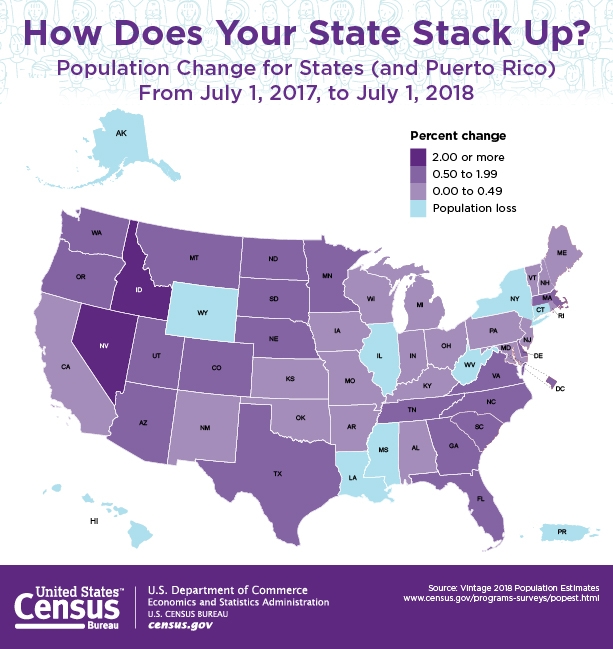The Census Bureau’s Population Estimates Program (PEP)
produces annual estimates of the residential population for various geographies,
including the United States, its states, counties, cities, and towns, as well
as for the Commonwealth of Puerto Rico and its municipios. PEP annually
utilizes current data on births, deaths, and migration to estimate the change
in population for each geography encompassed by the program, comparing current
estimates to those recorded during the most recent decennial census. These are
the estimates used for federal funding allocations and as survey controls for
the upcoming American Community Survey release each year.
Population estimates for 2018, spanning the period between July
1, 2017 and July 1, 2018, were released in December for states, Puerto Rico, and
the nation. However, population estimates for 2018 are not scheduled to be released
for counties, cities, towns, and metro/micropolitan statistical areas until next
month.
Population Growth in the U.S.
According to the data provided by the PEP, the population in
the United States continued to grow, by 0.6 percent, over the period from July
1, 2017 to July 1, 2018. Furthermore, the voting age population, consisting of those
18 years and over, increased by 0.9 percent to reach a total of 253,768,092
people in 2018. Following a trend observed in previous years, population growth
for the nation as a whole was the result of both natural increase (the excess
of births over deaths) and steady international migration. While international
migration was slightly higher last year (978,826 compared to 953,233 the year before),
natural increase was slightly lower last year (1,041,487 compared to 1,122,546
the previous year).
Although the population in the U.S has continued to grow throughout
the years, the rate of natural increase has steadily declined over the past
decade — resulting from fewer births in recent years and an increasing number
of deaths. Nationally, natural increase (the excess of births over deaths) was
nearly 1.04 million last year, accounting for 3,855,500 births and 2,814,013
deaths. Yet just a decade ago, in 2008, natural increase for the nation stood
at nearly 1.8 million.
How States Compare
In the last year alone, Nevada and Idaho tied for the top
spot as the nation’s fastest-growing state — in terms of population growth from
July 1, 2017 through July 1, 2018. Both states experienced a population surge
of nearly 2.1 percent, resulting from both natural increase and positive net migration,
well above the national rate of 0.6 percent for the year. Closely trailing Nevada
and Idaho for the largest percentage increases in population were Utah (1.9 percent),
Arizona (1.7 percent), Florida (1.5 percent), and Washington (1.5 percent). Michigan’s
positive, yet modest, population growth (0.3 percent) ranked 35th last
year, though we were the 10th most populous state in the nation (9,995,915
residents) following North Carolina (10,383,620 residents). Although Florida experienced
the highest level of net domestic migration in the last year, with 132,602 more
people migrating to the state than those exiting, an excess of deaths relative
to births has prevented the state from claiming the top spot.

Unlike Florida, there were nine states in the last year — in
addition to Puerto Rico — where the population gains associated with migration
could not mitigate the losses resulting from an excess of deaths over births. The
nine states where population losses occurred were New York (a decline of
48,510), Illinois (45,116), West Virginia (11,216), Louisiana (10,840), Hawaii
(3,712), Mississippi (3,133), Alaska (2,348), Connecticut (1,215) and Wyoming
(1,197).
Future Data Topics
Have you been enjoying these “Data Points” blogs and are
interested in other data? Let us know what topics you’d like to know more about
on our Twitter @WMTalent2025! We’d like to crunch some numbers that you’re
interested in!


